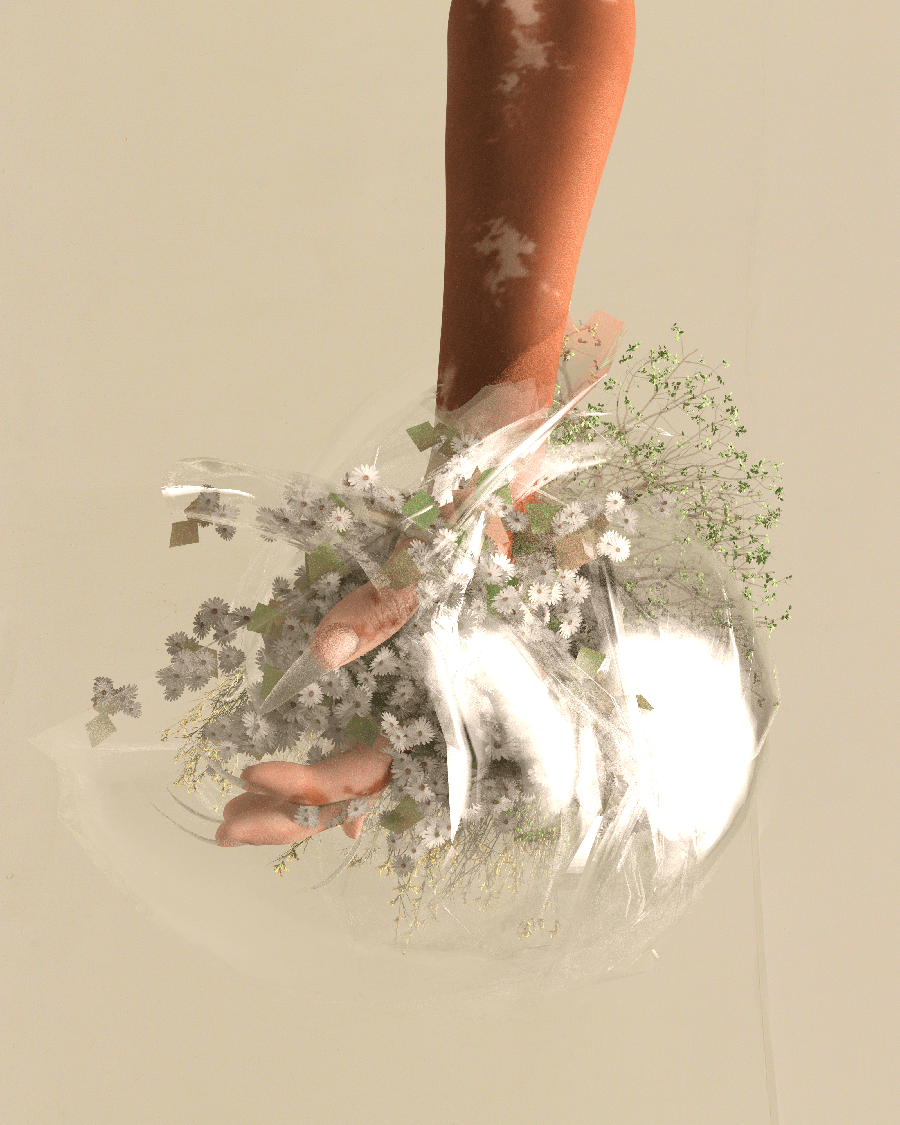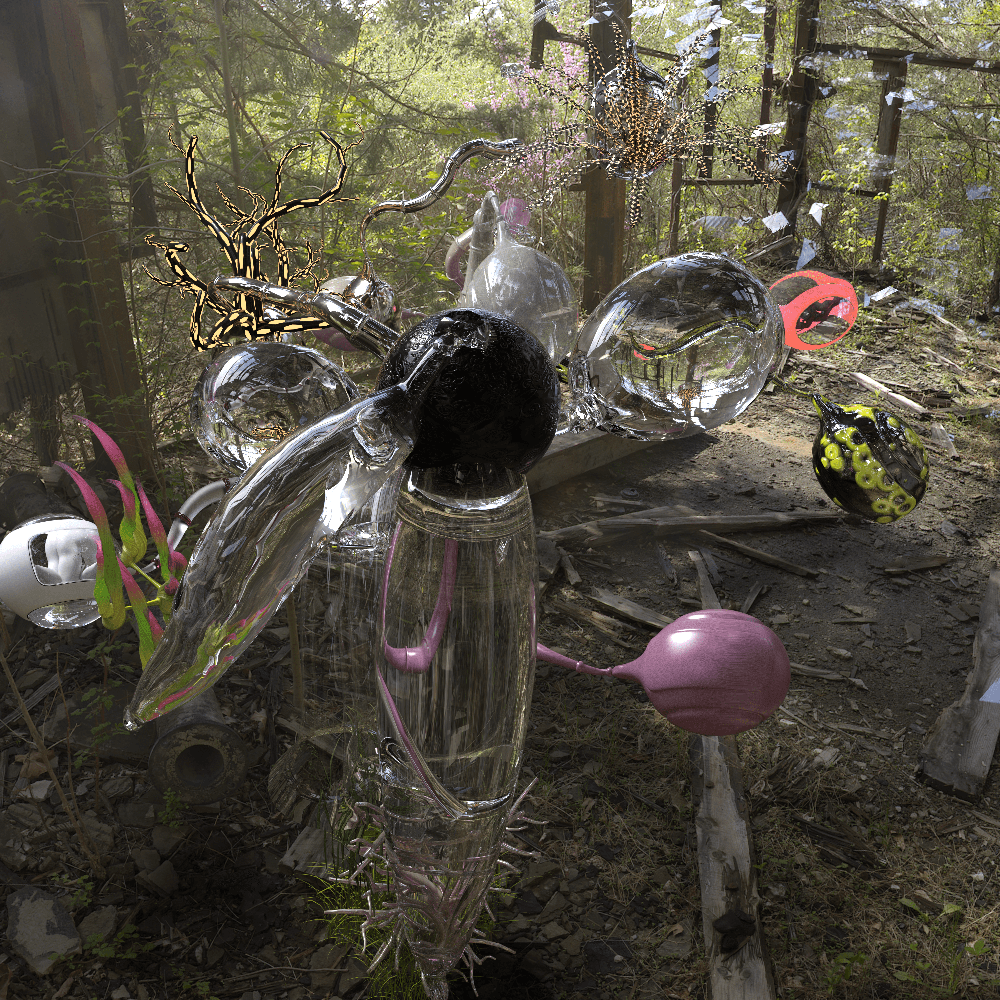Helin Sahin
azadi, 2020
Multitalented and ever-evolving Kurdish artist, Helin Sahin builds her expanding visual artistry with surrealistic 3D modeling and digital sculpting, imbuing empty virtual canvases with meaning and personal value. Sahin transforms natural elements, such as glass, water and hair, into a reality entirely of their own, acting as a visual expression of her own subconscious and working closely with concepts which relate to her own Kurdish heritage, as well as post-internet aesthetics.
j-drop, 2021
With 14 exhibitions under her belt, as well as collaborations with Flora Miranda and Burberry, Sahin’s work reads as the embodiment of her personal process, challenging not only the limits of what she can visually create, but the potential of a reality which is dynamic in it’s constant pushing of its audience to see beyond the limits of comprehension.
home, 2018
Hi Helin! So amazing to speak with you – what have you been getting up to lately?
Hi, likewise! Lately, I’ve been designing a cover artwork for an upcoming music festival. Also writing an exposé for a personal project. Non-artistically, since some time now, I’ve been dealing with all kinds of bureaucratic difficulties and delays. I moved from the US to Germany last year, so still trying to re-acclimate and survive.
dual nature, 2020
Professionally sounds like a dream, but I know from personal experience that cross-continental moving can be such a bureaucratic nightmare – not to mention the intense culture shock. Your works are absolutely gorgeous, and so clean and refined – where do you feel like your stylistic inspiration comes from? Whether it be another artist, natural elements, or maybe just abstract feelings or emotions.
Thank you. Form and content are equally important for me; so let me start with, so to say, narrative of the process. In my work, I try to explore the representational possibilities of identity, belonging and memory. I rely on deconstruction of conventional perceptions both conceptually and visually. I seek to develop different approaches to digitizing these notions. This is a very personal process, far from rigid strategies, and I’m working very closely with my subconscious and emotional state. This flow helps me gain clarity about myself and makes the work very personal.
urchin, 2020
Stylistically, I draw in a lot from my contents. In this sense, no matter how futuristic the forms or figures in my works may seem, they are highly related to the past and memory. Visual expression of the subconscious, post-internet aesthetics and network culture, Kurdish iconology and mysticism are among the main areas that I feed on.
in my bed, 2017
I think you definitely see this personal narrative constructing itself in all of your pieces. Aside from stunning visual artistry, your works have also found themselves as key components on the runway. What was it like to create the background videos for the Flora Miranda shows in LA and Vancouver fashion week? How did you visualize it interacting with both the collection and the audience?
I think Flora’s approach and mine, in what we do, have much in common. We are both working quite interdisciplinary and experimental with similar values and creative styles. Her designs tend to blur the borders between art and fashion. Both of the fashion shows were very meaningful collaborations and a great experience for me. The initial focus was to keep the main components of the collection ever present in the visuals, without distracting the audience from the garments. I think both the collection and the visuals had a very harmonious connection.
cybersensuality, 2017
I think this harmony present between the two made the runway as an experience a work of visual artistry in and of itself! The videos from the catwalk are breathtaking. In addition to this, you also collaborated with Burberry for the Inside Nature campaign. What was the approach you took to translate an iconic fashion house into your own interpretation of visual artistry? What components did you find most important from the brand to harmonize within your own distinct style?
It was about a year into the pandemic when Burberry asked me to create one to three bespoke pieces of artwork that provided my own personal take on ‘Inside Nature’. It was an incredibly uncertain time for all. I was also struggling to produce work and concentrate on projects. I read their creative brief and thought the theme was quite intriguing and topical. My approach was to incorporate the spirit and freedom of nature, the outdoor world, in an enclosed space, while creating something that stays true to my creative style. As someone who is utterly indifferent to fashion and brands, I would say the only creative cue that I got from the brand was the color scheme of their iconic print with lots of tan, cream, black and brown.
sad, 2017
There’s definitely a warmness with the color pallet that is very Burberry to me, but then a freshness and, indeed, very freeing energy from all three pieces. I love the coolness and airiness consistent throughout your work, which I think comes about especially through your rendering of transparent glass and glossy hairs throughout multiple of your pieces. What draws you so much to these elements and how does the medium of 3D sculpting expand your artistic potential to manipulate these aspects? One of my favorite parts of your work is the way it plays with what is possible and the ability to bend them beyond their natural will.
I constantly discover new ways to build my visual language. As I like to say, it’s an ongoing digital experiment. With my choices of the materials and shaders, I try to permeate the form with new symbolic connotations by taking it out of it’s own “reality”. To me, this is a way of understanding reality and theorizing about the world. It’s a way of making sense of the world intellectually. Materials such as glass, water and glossy hair are an enduring trend in my work. I feel like there are so many possibilities in transparency and reflection, which leads me to explore different things. I appreciate the unexpected dynamism these materials bring; the magnificent cast of colors and reflections has a natural flow that repeats itself in complex forms throughout. As much as the figures and materials themselves, the space that also becomes their material is very important to me. The physical presence of the digital sculpture gives meaning and value to the empty space.
inside nature, 2020
“Bending the possibilities beyond their natural will” is in fact a good way to put it. The fact that the visual language of my works contains surreal elements and that I present it in a partially realistic way often puts the audience in a dilemma. Through this dichotomy, I seek to rearticulate perception and meaning of reality. I enjoy witnessing different ways of seeing and reading evoked by this unfamiliar process of creation. For me, it helps to escape the limits of perception and experience.
inside nature, 2020
xani 2.0, 2020
I think this dilemma that you put the viewer in is something so close to sublimity – awe and uncertainty as our brains try to understand the mechanisms of what’s before us, and also executed so beautifully. You’ve been featured in so many breathtaking exhibitions all over the world – what was one museum or gallery experience, which stood out to you personally? I can imagine that it can be a surreal experience to be physically surrounded by your works in a space, but maybe a specific curation, environment, or even period of your life can influence the impact of that encounter so vividly.
There are many. But as far as the displaying techniques considered, the ones which were held at the Superchief Gallery in Los Angeles and Miami were quite progressive and bold. The Wrong Biennial was also very interesting and forward thinking. It was divided into online and real life locations around the world. Each of the official pavilions and embassies had team of curators responsible to select its participating artists. There were many participating embassies; the one that I was a part of was at the El Museo Universitario del Chopo in Mexico.
Curational wise, I think the Bé Welat exhibition at the nGbK in Berlin was quite impressive. The works were powerfully presented in a diverse and media-rich exhibition. It was a Kurdish contemporary art exhibition and the space was imbued with so much energy and enthusiasm with the works of artists from Kurdistan and the diaspora. There were a wide variety of mediums; from video to digital art, to painting and photography.
PS, 2019
That sounds absolutely amazing! I think one of my favorite parts of experiencing how the works interact with not only the exhibition space itself, but also the other artists present, and I can imagine that Bé Welat felt like almost a chorus of artistry.
Thank you so much for taking the time to answer my questions! I’m absolutely ecstatic to see what you come out with next. As a final question, I saw that you also have another project you're working on @archivemedina. Naturally your Kurdish heritage is ever-present within your visual artistry, and I feel like your curation of this is such a gorgeous extension of that. How would you say the two projects compare in the ways that you hope to communicate yourself through your works?
My approach in archiving is an enduring remembrance, yearning and connection. I think these photographs from Kurdistan are central to this outlook. Even though I stopped updating the archive for some time now, I’m still continuing my research. I learn and unlearn things everyday through the work of archiving. My practice and the archive projects (I’ve got two other) feed off each other quite well. I believe as long as my archive projects are relevant; they will continue to nurture and influence me and my practice.
untitled, 2018
xewneke kurt, 2021
interview ALIA AYOUBI
mastery YANYAN
What to read next




















